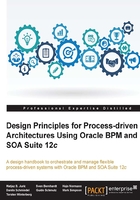
The postmature birth of enterprise BPM
When enterprise architects discuss the future of the software landscape of their organization, they map the functional capabilities, such as customer relationship management and order management, to existing or new applications—some packaged and some custom. Then, they connect these applications by means of middleware. They typically use the notion of an integration middleware, such as an enterprise service bus (ESB), to depict the technical integration between these applications, exposing functionality as services, APIs, or, more trendy, "micro services".
These services are used by modern, more and more mobile frontends and B2B partners. For several years now, it has been hard to find a PowerPoint slide that discusses future enterprise middleware without the notion of a BPM layer that sits on top of the frontend and the SOA service layer. So, in most organizations, we find a slide deck that contains this visual box named BPM, signifying the aim to improve process excellence by automating business processes along the management discipline known as business process management (BPM).
Over the years, we have seen that the frontend layer often does materialize as a portal or through a modern mobile application development platform. The envisioned SOA services can be found living on an ESB or API gateway.
Yet, the component called BPM and the related practice of modeling executable processes has failed to finally incubate until now—at least in most organizations. BPM still waits for morphing from an abstract item on a PowerPoint slide and in a shelved analyst report to some automated business processes that are actually deployed to a business-critical production machine.
When we look closer—yes—there is a license for a BPM tool, and yes, some processes have even been automated, but those tend to be found rather in the less visible corners of the enterprise, seldom being of the concern for higher management and the hot project teams that work day and night on the next visible release. In short, BPM remains the hobby of some enterprise architects and the expensive consultants they pay.
Will BPM ever take the often proposed lead role in the middleware architect's tool box? Will it lead to a better, more efficient, and productive organization?
To be very honest, at the moment the answer to that question is rather no than yes. There is a good chance that BPM remains just one more of the silver bullets that fill some books and motivate some great presentations at conferences, yet do not have an impact on the average organization.
But there is still hope for enterprise BPM as opposed to a departmental approach to process optimization.
There is a good chance that BPM, next to other enabling technologies, will indeed be the driver for successful enterprise modernization. Large organizations all over the globe reengage with smaller and larger system integrators to tackle the process challenge. Maybe BPM as a practice needs more time than other items found in Gardner hype curves to mature before it's widely applied. This necessary level of higher maturity encompasses both the tools and the people using them.
Ultimately, this question of large-scale BPM adoption will be answered inpidually in each organization. Only when a substantive set of enterprises experience tangible benefits from BPM will they talk about it, thus growing a momentum that leads to the success of enterprise BPM as a whole. This positive marketing based on actual project and program success will be the primary way to establish a force of attraction towards BPM that will raise curiosity and interest in the minds of the bulk of the organizations that are still rather hesitant or ignorant about using BPM.